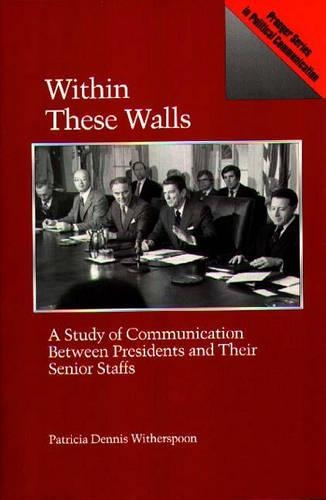
Within These Walls: A Study of Communication Between Presidents and Their Senior Staffs
(Hardback)
Publishing Details
Within These Walls: A Study of Communication Between Presidents and Their Senior Staffs
By (Author) Patricia D. Witherspoon
Bloomsbury Publishing PLC
Praeger Publishers Inc
30th January 1991
United States
Classifications
Tertiary Education
Non Fiction
Regional, state and other local government
353.032
Physical Properties
Hardback
272
Description
Filling a crucial gap in research on the presidency and presidential communication, Within These Walls goes beyond the study of presidential speeches and examines the organizational structure, systems of information flow, and communication styles in the administrations of Franklin Roosevelt through Ronald Reagan. Focusing principally on the post-Watergate presidents, this book illustrates that a primary dimension of presidential communication is not that which is spoken during public addresses but that which takes place between the chief executive and his senior staff. Patricia Witherspoon's exhaustive research includes archival material from the Ford and Carter presidential libraries as well as information obtained from interviews with President Ford and several former senior aides in the Ford, Carter, and Reagan White Houses. Applying organizational theory to her study of the modern presidency, Witherspoon reveals that the White House, as we know it today, began its evolution into a modern organization during the FDR administration. It shares a variety of characteristics common to other organizations, including formal and emergent structures, formal and informal systems of information flow, and decision-making processes and managerial and communication styles selected and/or assumed by the organizational leader (the president). Students and scholars of political communication, political science, history, management and public policy, or any informed reader concerned with the modern presidency will find Within These Walls a source of valuable insight.
Reviews
A useful and clearly written analysis of how modern US presidents (Franklin Roosevelt to Ronald Reagan) have communicated with their senior staff members. Most studies in presidential communications examine how chief executives present themselves to the public. Witherspoon . . . offers a different and helpful perspective by focusing on processes of internal White House deliberations. Emphasizing the post-Watergate presidents, Witherspoon relies on personal interviews with former White House staff members, on documents contained in the Gerald R. Ford and Jimmy Carter presidential libraries, as well as on some of the leading academic literature. The presentation of new material from the author's interviews add to the scholarly value of the volume. Useful insights into how presidents manage staff, make decisions, and handle internal conflict are also offered. A good addition to the academic literature, this book is recommended to advanced students and scholars of the presidency and political communications. . . .-Choice
"A useful and clearly written analysis of how modern US presidents (Franklin Roosevelt to Ronald Reagan) have communicated with their senior staff members. Most studies in presidential communications examine how chief executives present themselves to the public. Witherspoon . . . offers a different and helpful perspective by focusing on processes of internal White House deliberations. Emphasizing the post-Watergate presidents, Witherspoon relies on personal interviews with former White House staff members, on documents contained in the Gerald R. Ford and Jimmy Carter presidential libraries, as well as on some of the leading academic literature. The presentation of new material from the author's interviews add to the scholarly value of the volume. Useful insights into how presidents manage staff, make decisions, and handle internal conflict are also offered. A good addition to the academic literature, this book is recommended to advanced students and scholars of the presidency and political communications. . . ."-Choice
Author Bio
PATRICIA DENNIS WITHERSPOON is Associate Dean of the College of Communication at the University of Texas, Austin. She has been a full- or part-time academic administrator in higher education since 1978. As a faculty member in the Department of Speech Communication, she has developed an interest in the study of organization leadership and communication, and currently teaches a course on that subject.
